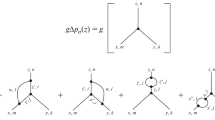Summary
For two particles in a single channel with identical quantum numbers, the compositeness conditions are carefully examined. With respect to a choice of the equations to determine the masses and the coupling constants of the particles in question, we make the following statement to be proved in the text;a) the condition\(\mathop {lim}\limits_{s \to \infty } s det Z(s) = 0\) is tenable as the «second» compositeness condition in addition to the «first» one\(\mathop {lim}\limits_{s \to \infty } det Z(s) = 0\), whereZ(s) denotes the matrix of the wavefunction renormalization function and becomes identical with the renormalization constant ass tends to infinity;b) when the second condition is employed,D(s)/D(s) must tend to zero ass goes to infinity, whereD(s) signifies the denominator function of the total scattering amplitude andD(s) that of its single-particle irreducible part. These results enable us to complete the discussion of the compositeness conditions for the present case in close analogy with the case of a single particle in a single channel.
Riassunto
Si sono accuratamente esaminate le condizioni perché siano composite due particelle in un solo canale con numeri quantici identici. Per quanto riguarda la scelta delle equazioni che determinano le masse e le costanti di accoppiamento delle particelle in questione, si fa la seguente asserzione che sarà dimostrata nel testo:a) la condizione ims detZ(s)=0 si può mantenere come «seconda» condizione di composizione in aggiunta alla «prima»\(\mathop {lim}\limits_{s \to \infty } det Z(s) = 0\), in cuiZ(s) denota la matrice della funzione di rinormalizzazione della funzione d'onda e diventa identica con la costante di rinormalizzazione quandos tende all'infinito;b) quando si adopera la seconda condizione,D(s)/D(s) deve tendere a zero quandos tende all'infinito, doveD(s) indica la funzione denominatore dell'ampiezza di scattering totale eD(s) quella della sua parte irriducibile di particella singola. Questi risultati ci permettono di completare la discussione sulle condizioni di composizione nel caso presente in stretta analogia col caso di una sola particella in un solo canale.
Резюме
Внимательно изучаются условия сложности для двух частиц в отдельном канале с тождественными квантовыми числами. Что касается выбора уравнений для определения масс и констант связи рассматриваемых частиц, мы делаем сдедующее утверждение, которое доказывается в тексте:a) условие\(\mathop {lim}\limits_{s \to \infty } s det Z(s) = 0\) является пригодным, как «второе» условие сложности, в дополнение к «первому» условию\(\mathop {lim}\limits_{s \to \infty } det Z(s) = 0\) гдеZ(s) определяет матрицу перенормированной волновой функции и становится тождественным с перенормировочной константой, когдаs стремится к бесконечности. б) когда используется второе условие,D(s)/D(s) должно стремиться к нулю, когдаs стремится к бесконечности, гнеD(s) представляет знаменатель функции полной амплитуды рассеяния иD(s) есть неприводимая одно-частичная частя этой амрлитуды. Эти результатй позвояяют нам завершить обсужности для рассматриваемого случая в тесной аналогии со случаем одной частицы в отдельном канале.
Similar content being viewed by others
References
For references, see the review articleK. Hayashi, M. Hirayama, T. Muta, N. Seto andT. Shirafuji:Fortsch. d. Phys.,15, 625 (1967).
T. Muta:Prog. Theor. Phys. (Kyoto),35, 1099 (1966).
J. C. Houard andC. le Guillou:Nuovo Cimento,44 A, 484 (1966).
K. Kang:Phys. Rev.,152, 1234 (1966);Nuovo Cimento,49 A, 415 (1967).
M. Hirayama:Prog. Theor. Phys. (kyoto),38, 476 (1967).
K. Kang:Nuovo Cimento,51 A, 205 (1967), Preprint NYO-2262 TA-162.
P. K. Srivastava andS. Rai Choudhury:Nuovo Cimento,39, 650 (1965);43 A, 239 (1966).
H. Yabuki:Prog. Theor. Phys. (Kyoto),35, 889 (1966).
Author information
Authors and Affiliations
Additional information
Tranduzione a cura della Redazione
Переведено редакцией.
Rights and permissions
About this article
Cite this article
Hayashi, K., Hirayama, M., Seto, N. et al. Comments on the compositeness conditions for particles with identical quantum numbers. Nuovo Cimento A (1965-1970) 57, 746–752 (1968). https://doi.org/10.1007/BF02751379
Received:
Published:
Issue Date:
DOI: https://doi.org/10.1007/BF02751379




